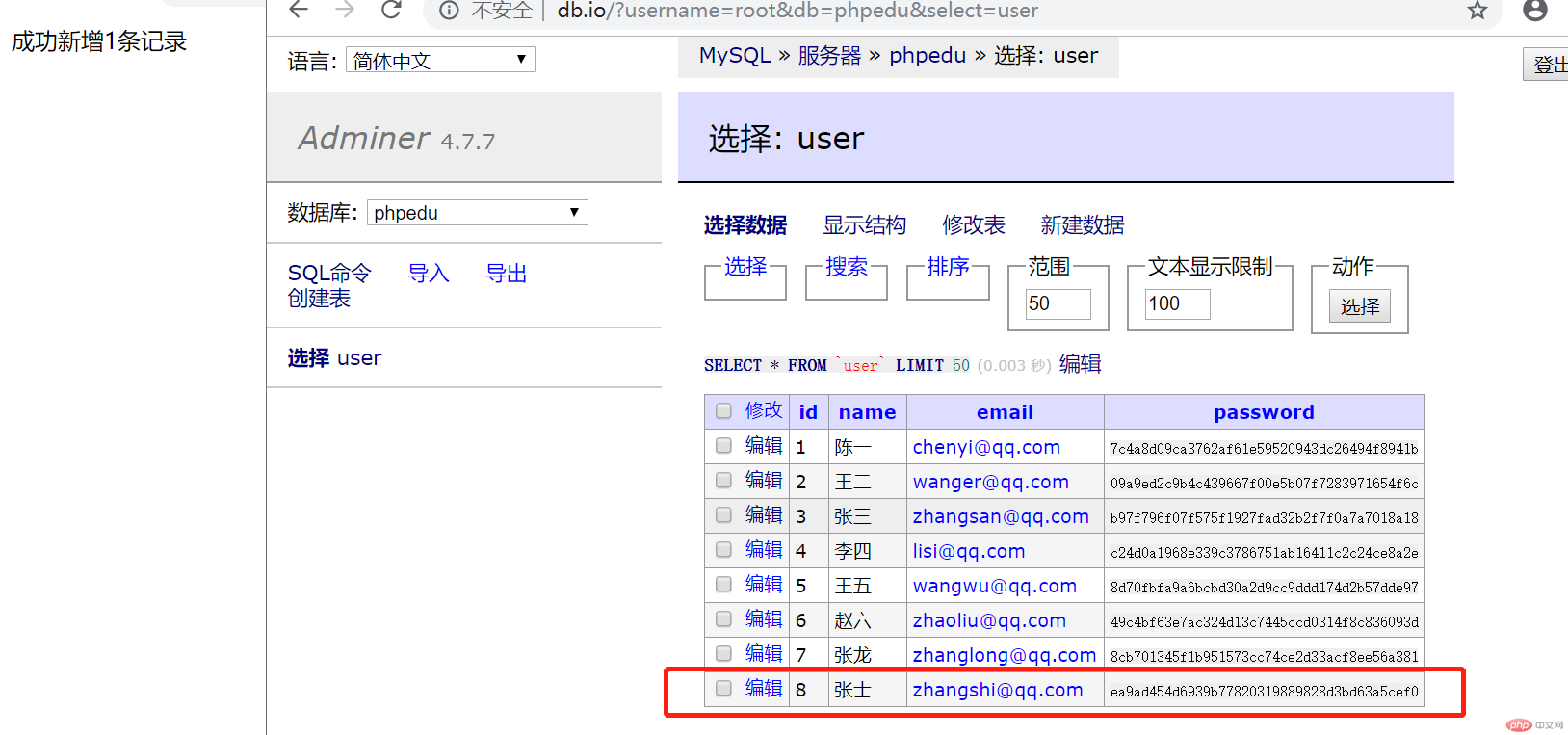批改状态:合格
老师批语:完成的不错, 如果不看源码, 能否自己写出来呢, 试试看
// 连接参数return [// 类型'type' => $type ?? 'mysql',// 默认主机名'host' => $username ?? 'localhost',// 默认编码集'charset' => $charset ?? 'utf8',// 默认端口号'port' => $porst ?? '3306',// 默认用户名'username' => $usernam ?? 'root',// 默认用户的密码'password' => $password ?? 'root',// 默认数据库'dbname' => $dbname ?? 'phpedu',];
// 1. 导入配置参数//__DIR__获取当前目录的路径$config = require __DIR__ . '\\0829-1config.php';// print_r($config);extract($config);// new PDO(数据源, 用户名, 密码);// $dsn = '数据库类型:host=主机名;dbname=默认数据库;charset=默认编码集;port=默认端口';// $dsn = 'mysql:host=localhost;dbname=phpedu;charset=utf8;port=3306';try {//要执行的代码,$dsn代表数据源$dsn = sprintf('%s:host=%s;dbname=%s',$type,$host,$dbname);$pdo =new PDO($dsn, $username, $password);// var_dump($pdo);} catch (PDOException $e) {die($e->getMessage());}
新增数据
// 1、连接数据库$config = require __DIR__ . '\\0829-2.php';//2、操作// ?占位符;:name命名占位符$sql = 'INSERT `user` SET `name`=?, `email`=?, `password`=?;';//将?分别替换成:name,:email,:password;占位符前面的:可以不加// sql语句对象(预处理对象)$stmt = $pdo->prepare($sql);// var_dump($stmt);// 将占位符与变量名绑定//1)bindParam()参数绑定// bindParam(): 参数与指定的变量名进行绑定,也叫引用传参//常量:PDO::PARAM_STR表示 SQL 中的 CHAR、VARCHAR 或其他字符串类型$stmt->bindParam(1, $name, PDO::PARAM_STR, 30);//$stmt->bindParam(':name', $name, PDO::PARAM_STR, 30);$stmt->bindParam(2, $email,PDO::PARAM_STR, 100);//$stmt->bindParam(':email', $email, PDO::PARAM_STR, 100);$stmt->bindParam(3, $password, PDO::PARAM_STR, 40);//$stmt->bindParam(':password', $password, PDO::PARAM_STR, 40);//变量名与值进行绑定$name = '张龙';$email = 'zhanglong@qq.com';$password = sha1('156793');//执行$stmt->execute();//简易方法:可以省略参数绑定的步骤,直接在execute()传参时进行绑定,但此时参数必须放在一个数组中// 如:?匿名占位符可写成$stmt->execute(['张龙2','zhanglong2@qq.com',sha1('1562793')]);// 如:使用命名占位符, 则需传一个关联数组,键名就是占位符,可写成$res=$stmt->execute(['name'=>'张龙2', 'email'=>'zhanglong2@qq.com','password'=> sha1('1562793')]);//2)bindValue()值绑定// $name='张士';// $email='zhangshi@qq.com';// $password=sha1('589802');// $stmt->bindValue(1,$name,PDO::PARAM_STR);// $stmt->bindValue(2,$email,PDO::PARAM_STR);// $stmt->bindValue(3,$password,PDO::PARAM_STR);// $stmt->execute();//rowCount():返回操作成功后受影响的记录数量,这里是指新增的记录数量echo '成功新增'.$stmt->rowCount().'条记录';// 3、关闭// $pdo = null;unset($pdo);


// 1、连接数据库$config = require __DIR__ . '\\0829-2.php';//2、操作// ?占位符;:name命名占位符$sql = 'INSERT `user` SET `name`=:name, `email`=:email, `password`=:password;';// sql语句对象(预处理对象)$stmt = $pdo->prepare($sql);$res=$stmt->execute(['name'=>'张龙2', 'email'=>'zhanglong2@qq.com','password'=> sha1('1562793')]);echo '成功新增'.$stmt->rowCount().'条记录';// 3、关闭// $pdo = null;unset($pdo);

// 1、连接数据库$config = require __DIR__ . '\\0829-2.php';//2、操作// 更新数据时一定要有条件$sql = 'UPDATE `user` SET `name`=?, `email`=?, `password`=? WHERE `id` = ?;';// sql语句对象(预处理对象)$stmt = $pdo->prepare($sql);$res=$stmt->execute(['赵虎', 'zhaohu@qq.com',sha1('580293'),9]);//rowCount():返回操作成功后受影响的记录数量,这里是指新增的记录数量echo $stmt->rowCount() === 1 ? '成功更新了 ' . $stmt->rowCount() . ' 条记录' : '没有记录被更新';// 3、关闭unset($pdo);

// 1、连接数据库$config = require __DIR__ . '\\0829-2.php';//2、操作// 更新数据时一定要有条件$sql = 'DELETE FROM `user` WHERE `id` = ?;';// sql语句对象(预处理对象)$stmt = $pdo->prepare($sql);$res=$stmt->execute([8]);//rowCount():返回操作成功后受影响的记录数量,这里是指新增的记录数量echo $stmt->rowCount() === 1 ? '成功删除了 ' . $stmt->rowCount() . ' 条记录' : '没有记录被删除';// 3、关闭unset($pdo);

// pdo查询数据:fetch()+while()逐条遍历// 1、连接数据库$config = require __DIR__ . '\\0829-2.php';//2、操作// 更新数据时一定要有条件$sql = 'SELECT `id`,`name`,`email` FROM `user` WHERE `id` > ?;';// sql语句对象(预处理对象)$stmt = $pdo->prepare($sql);//给查询结果增加一个条件:符合时逐条遍历显示结果,否则打印错误信息if($stmt->execute([5])){// 逐条遍历,fetch()返回一维数组,将数据表的记录指针自动下移// $a = $stmt->fetch();// printf('<pre>%s</pre>',print_r($a,true));//数据查询完之后再进行遍历,则不会显示数据,可用while循环遍历操作while($a=$stmt->fetch()){printf('<pre>%s</pre>',print_r($a,true));}}else{// 返回一个错误信息的数组printf('<pre>%s</pre>',print_r($stmt->errorInfo(),true));// 调试方法:打印出执行的SQL预处理语句,进行检查$stmt->debugDumpParams();}// 3、关闭unset($pdo);

// pdo查询数据:fetchALl() + foreach()// 1、连接数据库$config = require __DIR__ . '\\0829-2.php';//2、操作// 更新数据时一定要有条件$sql = 'SELECT `id`,`name`,`email` FROM `user` WHERE `id` < ?;';// sql语句对象(预处理对象)$stmt = $pdo->prepare($sql);//给查询结果增加一个条件:符合时显示结果,否则打印错误信息if($stmt->execute([5])){// 一次性获取所有满足条件的数据信息$a = $stmt->fetchAll();//数据查询完以二维数组显示,可用foreach操作foreach($a as $value){vprintf('<li>id = %d, name = %s, email = %s</li>', $value);}}else{// 返回一个错误信息的数组printf('<pre>%s</pre>',print_r($stmt->errorInfo(),true));// 调试方法:打印出执行的SQL预处理语句,进行检查$stmt->debugDumpParams();}// 3、关闭unset($pdo);

// pdo查询数据:将每个字段绑定到变量上// 1、连接数据库$config = require __DIR__ . '\\0829-2.php';//2、操作// 查询数据时一定要有条件$sql = 'SELECT `id`,`name`,`email` FROM `user` WHERE `id` < ?;';// sql语句对象(预处理对象)$stmt = $pdo->prepare($sql);$stmt->execute([5]);// 将三个字段与三个变量进行绑定,通过列名进行绑定$stmt->bindColumn('id', $id);$stmt->bindColumn('name', $name);$stmt->bindColumn('email', $email);while ($user = $stmt->fetch()) {printf('<pre>%s</pre>',print_r($user,true));}// 3、关闭unset($pdo);

//查询符合条件的记录数量// 1、连接数据库$config = require __DIR__ . '\\0829-2.php';//2、操作//获取满足条件的记录数量不能用$stmt->rowCount(),要用COUNT(*)// COUNT(*):字段名,并不直观,所以给个别名$sql = 'SELECT COUNT(*) AS `count` FROM `user` WHERE `id` < ?;';// 预处理语句$stmt = $pdo->prepare($sql);$stmt->execute([5]);//将别名count绑定到变量$stmt->bindColumn('count', $count);$stmt->fetch(PDO::FETCH_BOUND);echo '满足条件记录数量是: ', $count, ' 条记录';// 3. 关闭$pdo = null;

//1、实现代码复用,图片单继承限制trait Demo{public function getUser(){return '姓名:'.$this->name.',年龄:'.$this->age.'岁';}}trait Demos{public function getUsers(){//get_class_vars() 函数返回由类的默认属性组成的数组;参数为类名//self可以访问本类中的静态属性和静态方法,可以访问父类中的静态属性和静态方法。用self时可以不用实例化//__CLASS__:当前类的名称;等价于self::classreturn sprintf('<pre>%s</pre>', print_r(get_class_vars(self::class), true));}}class Demo1{//插入多个trait,用,隔开use Demo,Demos;//相当于把Demo和Demos的方法都复制到了本类中protected $name='张三';protected $age='30';}class Demo2{use Demo;protected $name='李四';protected $age='40';}echo (new Demo1)->getUser().'<br>';echo (new Demo1)->getUsers().'<br>';echo (new Demo2)->getUser().'<hr>';

//2、trait支持继承trait Demo{public $name='李四';public function getUser(){//__METHOD__:返回该方法被定义时的名字(区分大小写)return 'trait method name : ' . __METHOD__;}}class Demo1{use Demo;}class Demo2 extends Demo1{}echo (new Demo2)->getUser().'<br>';echo (new Demo2)->name.'<hr>';//静态属性及方法trait Demos{public static $name='张三';public static function get(){//__METHOD__:返回该方法被定义时的名字(区分大小写)return 'trait method name : ' . __METHOD__;}}//可以使用抽象类(abstract)使用straitabstract class Demo3{use Demos;}// 给用户提供的工作类/实现,应该尽可能的简单,可以将一些实现细节进行隐藏class Demo4 extends Demo3{}//静态属性的调用方法为"类名::属性名"echo Demo4::get().'<br>';echo Demo4::$name;

//3、trait扩展trait Demo{public function getUser(){return '姓名:'.$this->name.',年龄:'.$this->age.'岁';}}trait Demos{public function getUsers(){//get_class_vars() 函数返回由类的默认属性组成的数组;参数为类名return sprintf('<pre>%s</pre>', print_r(get_class_vars(self::class), true));}}//同时引入多个trait,用,隔开;trait支持功能整合,trait中允许再引入traittrait tDemo{use Demo,Demos;}class Demo1{use tDemo;//tDemo中已经整合了Demo和Demos,此时只需要引入一个tDemo即可protected $name='张三';protected $age='30';}echo (new Demo1)->getUser().'<br>';echo (new Demo1)->getUsers();

//4、trait成员的命名冲突trait Demo{public function getUser(){return '姓名:'.$this->name.',年龄:'.$this->age.'岁';}}trait Demos{public function getUser(){//get_class_vars() 函数返回由类的默认属性组成的数组;参数为类名return sprintf('<pre>%s</pre>', print_r(get_class_vars(self::class), true));}}trait tDemo1{protected $profession='司机';public function getUser(){// return __METHOD__;return '姓名:'.$this->name.',年龄:'.$this->age.'岁,职业:'.$this->profession;}}//同时引入多个trait,用,隔开;trait支持功能整合,trait中允许再引入traittrait tDemo{use Demo,Demos,tDemo1{//Demo和Demos中的方法名冲突,先替代,然后起别名//替代:用Demo::getUser将Demos::getUser替换掉,也就是只有Demo中的方法起作用Demo::getUser insteadOf Demos;Demos::getUser insteadOf tDemo1;//用Demos::getUser将tDemo1::getUser替换掉//别名:给Demos::getUser起别名Demos::getUser as getUsers;tDemo1::getUser as td;//给tDemo1::getUser起别名}}class Demo1{use tDemo;//tDemo中已经整合了Demo和Demos,此时只需要引入一个tDemo即可protected $name='张三';protected $age='30';}echo (new Demo1)->getUser().'<br>';echo (new Demo1)->getUsers().'<br>';echo (new Demo1)->td();//2个以上的trait成员命名冲突时如何做???

//5、trait与interface组合//创建接口,在创建前先判断当前接口是否存在//interface_exists() 函数检查接口是否已被定义if (!interface_exists('iDemo')){interface iDemo {// 创建一个静态抽象方法//接口的方法必须是public(默认是public),且接口中只能定义方法名(含参数),不能有函数体public static function index();public static function user();}}//用trait实现接口中的方法trait tDemo{// 将抽象类的实现代码写到trait中public static function index(){return __METHOD__;}public static function user(){return 'Hello Word!';}}//要实现一个接口,需使用 implements 操作符,类中必须实现接口中定义的所有方法abstract class work implements iDemo{use tDemo;}class works extends work{}echo works::index().'<br>';echo works::user();

interface常用场景
//interface:接口;接口完全的分离了:设计(接口)与实现(实现类)//1、单接口的实现interface A{//接口中只能定义方法名(含参数),不能有函数体;接口的方法必须是public(默认public)public function write();//接口中不能有属性,但可以定义常量const NAME='胡八一';//接口不能进行实例化,但可以有构造方法// public function __construct();}//要实现一个接口,使用 implements 操作符,类中必须实现接口中定义的所有方法class userA implements A{protected $age=33;public function write(){return '姓名:'.A::NAME.',年龄:'.$this->age.'岁';}}echo (new userA)->write().'<hr>';//2、接口继承、实现多个接口interface B extends A{//B接口继承A接口const NATION='CHINA';}interface C extends A,B{//C接口继承A和B接口public static function work();//多个接口进行整合,形成一个统一的接口,再用一个类实现}//一个类可以同时实现多个接口,实现多个接口时,接口中的方法不能有重名//实现类class userB implements C{public function write(){return '姓名:'.A::NAME.',国籍:'.B::NATION;}public static function work(){return __METHOD__;}}echo (new userB)->write().'<br>';echo (new userB)->work().'<hr>';// php是典型的单继承式语言// 接口之间允许继承,并用支持多继承// 可以有二种实现方案:// 1)将多个接口进行整合,形成一个统一的接口,然后用一个实现类来实现它// 2)一个实现类同时实现多个接口,实现类的功能组合,是一种横向功能扩展

抽象类与interface的区别与联系
//abstract抽象类: 部分的分离了: 设计(抽象类)与实现(工作类)abstract class user{protected $name='张三';//抽象类中的方法可以有抽象方法,也可以有非抽象方法public function work(){return __METHOD__;}//抽象方法:只其调用方式(参数),没有具体的实现过程,即没有函数体abstract function write();}// 抽象类禁止实例化// 抽象类必须使用它的子类才可以访问/工作class user1 extends user{public function write(){return $this->name;}}echo (new user1)->work().'<br>';echo (new user1)->write();

简单抽奖
//设置抽奖接口interface drawId{public static function getDrawId($min,$max);}//公共方法:实现抽象接口方法trait tDrawId{public static function getDrawId($min,$max){//mt_rand()生成随机整数return mt_rand($min,$max);}}//实现工作类class Draw implements drawId{use tDrawId;public static function award($prizes,$id){return $prizes[$id];}}$prizes=['电脑','手机','平板','相机','音箱','耳机','U盘'];$id=Draw::getDrawId(0,6);$prize=Draw::award($prizes,$id);//随机输出$prizes中的值echo '你的奖品是:'.$prize;

双色球
<?php//抽奖案例:双色球//设置抽奖接口interface drawId{public static function getDrawId($min,$max);}//公共方法:实现抽象接口方法trait tDrawId{public static function getDrawId($min,$max){//mt_rand()生成随机整数return mt_rand($min,$max);}}// 抽象类: 彩票(lottery)abstract class Lottery implements drawId{//引入traituse tDrawId;//生成中奖需要的编号,$num表示需要的数量protected static function createBalls($min,$max,$num){//1、按照开奖规则生成指定步长和数量的编号//range() 函数创建一个包含指定范围的元素的数组$allBalls=range($min,$max,1);//1为规定元素之间的步进制。默认是 1//2、蓝色球,生成$num=1个//array_rand(array,number):array必需,规定数组;number可选,规定返回多少随机键名//如果选出的元素不止一个,则返回包含随机键名的数组,否则返回该元素的键名if($num===1) return $allBalls[array_rand($allBalls)];//array_rand($allBalls)返回的是元素的键名,需要根据键名获取对应的值//3、红色球:随机6个球的编号$redBallsKeys=array_rand($allBalls,6);//返回6个随机元素的键名数组//根据键名获取对应的值$redBalls=[];foreach($redBallsKeys as $key){$redBalls[]=$allBalls[$key];}return $redBalls;}//抽象方法:生成一个中奖号:6个红色球+1个蓝色球abstract protected static function doubleBall($redRule,$blueRule);//抽象方法:生成一组试机号abstract protected static function doubleBalls($redRule,$blueRule,$range);}// 工作类: 抽奖(DrawLottery);用抽象类的子类去实现、访问class DrawLottery extends Lottery{//生成一个中奖号:6个红色球+1个蓝色球public static function doubleBall($redRule,$blueRule){//红色球规则:[1,33,6],1-33之间取随机6个数$redBalls=self::createBalls(...$redRule);sort($redBalls);//sort() 函数对数值数组进行升序排序//蓝色球规则:[1,16,1],1-16之间取随机1个数$blueBall=self::createBalls(...$blueRule);//红色+蓝色组成一个完整的中奖号//array_push() 向数组尾部插入一个或多个元素array_push($redBalls,$blueBall);//在$redBalls数组尾部添加一个值$blueBall//最终7个号码在$redBalls中return $redBalls;}//生成一组试机号public static function doubleBalls($redRule,$blueRule,$range){// 随机生成试机号的数量$count = self::getDrawId(...$range);$randBalls = [];for ($i = 0; $i < $count; $i++) {$randBalls[] = self::doubleBall($redRule, $blueRule);}// 返回最终生成一组开奖号return $randBalls;}}$draw = DrawLottery::doubleBall([1,33,6], [1,16,1]);// print_r($draw);$randBalls = DrawLottery::doubleBalls([1,33,6], [1,16,1],[1,6]);// print_r($randBalls);?><!DOCTYPE html><html lang="en"><head><meta charset="UTF-8"><meta name="viewport" content="width=device-width, initial-scale=1.0"><title>双色球开奖啦</title><style>.container{display:grid;grid-template-columns:repeat(7,40px);gap:15px;margin-bottom:15px;}.container >span{width:30px;height:30px;border-radius:50%;color:#fff;font-weight:700;text-align:center;line-height:30px;}.container >span:nth-of-type(-n+6){background-color:red;}.container >span:last-of-type{background-color:blue;}</style></head><body><h2>模拟双色球开奖</h2><h3>今日开奖号码: <small><?php echo date('Y年m月d日 H:i:s', time()); ?></small></h3><div class="container"><?php foreach ($draw as $item) :?><span><?php echo $item ?></span><?php endforeach ?></div><h3>今日试机号: </h3><?php foreach ($randBalls as $draws) :?><div class="container"><?php foreach ($draw as $item) :?><span><?php echo $item ?></span><?php endforeach ?></div><?php endforeach ?></body></html>


Copyright 2014-2025 https://www.php.cn/ All Rights Reserved | php.cn | 湘ICP备2023035733号